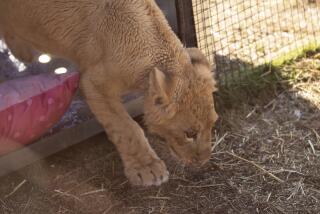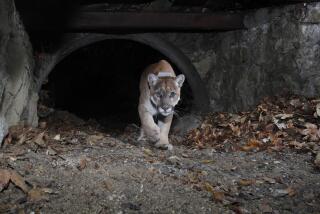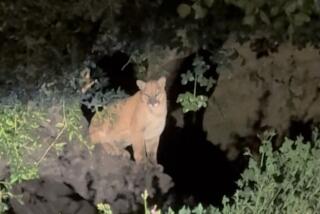Botswana Researchers : Providing the Lions’ Share of Knowledge
SAVUTI, Botswana — Petri Viljoen and his wife, Zanne, have spent most nights of the last 3 1/2 years staying up watching lions. They wanted to learn what lions like to eat, how far they roam and how they stack up as hunters.
This is what they found:
--Lions mostly prefer to eat buffalo.
--Some migrate as far as 20 miles in their search for food and some 45 miles, but others don’t roam at all.
--They aren’t very good hunters.
--They can go for months without water.
Petri, a 36-year-old biologist, and Zanne, 32, soon will leave Chobe National Park in northern Botswana, where they have been observing the lions, and return to South Africa, where he will turn his observations into a doctoral thesis at the Univerity of Witwatersrand.
Help for Wardens
Viljoen said the information he and his wife have gathered could help wildlife-park wardens manage and balance animal populations in southern Africa.
The Viljoens said the lions that live on the Savuti marsh, now dry but once the bed of a vast lake, have become almost like friends to them, particularly three with blond manes that they have nicknamed the Beach Boys.
Viljoen said there are only four other lion researchers living in the African bush--two at Serengeti in Tanzania, one at Etosha in Namibia (South-West Africa) and one in Kruger National Park in South Africa.
In their research, the Viljoens placed radio collars on 14 lions by darting them with a sedative, then fastening plastic transmitters around their necks. Collaring one lion per pride enabled them to follow the movements of dozens of animals over a 140-square-mile area.
The Viljoens’ research day usually begins about 4 p.m., when they drive out from their tent camp in a vehicle equipped with a radio receiver. The lions are becoming active then, and the couple don’t return to camp until about 9 a.m., when the lions seek shade and begin to sleep.
Good Sleepers
“Sometimes the lions also rest the whole night, and we spend our time watching nothing but sleeping lions,” Mrs. Viljoen said.
Viljoen said he sought answers to such questions as what animals lions prefer to eat, whether they migrate and, if so, how far and how whether lions perform in competition with other predators.
“We found that buffalo make up more than 30% of lion kills and provide most of the lions’ diet,” Viljoen said. “Warthogs provide most of the kills but, since they are smaller, less food intake than buffalo. Other favorites are zebra and impala.
“An interesting fact is that rare antelope, like sable and roan, do not make up a significant percentage of the lions’ diet, and lions cannot be considered a threat to these species.
“We also found that keeping migration routes open is important, since buffalo are migratory. If fences were built across migration routes, the lions would have to change their diet.”
About 60% of the Chobe lions move up to 20 miles with seasonal rains to find food, and another “nomadic” 20% move up to 45 miles, Viljoen said. Only 20% stay put.
Crafty Hyenas
He said lions can go for several months during the dry season without drinking water because they get enough fluid from eating animals.
“One of the surprises was to see how lions have difficulty in killing,” he said. “They are not very efficient hunters.” He calculates that lions lose about 11% of their prey to hyenas who muscle in on the kill.
“At times, we saw lions fanning out, seemingly forming a fantastic ambush,” Zanne Viljoen said. “Then a warthog ran past and suddenly the lions didn’t seem interested; there was a breakdown in communication.”
She said that females do most of the hunting “because the males have so many other duties, like patrolling,” but that males allow females only a few minutes to feed before they take over a carcass.
More to Read
Sign up for Essential California
The most important California stories and recommendations in your inbox every morning.
You may occasionally receive promotional content from the Los Angeles Times.










